This post may contain affiliate links. Please read our disclosure policy.
Two simple DIY’s for fresh homemade coconut cream – a creamy, thick, dairy-free, gluten-free cream alternative with tonnes of uses.
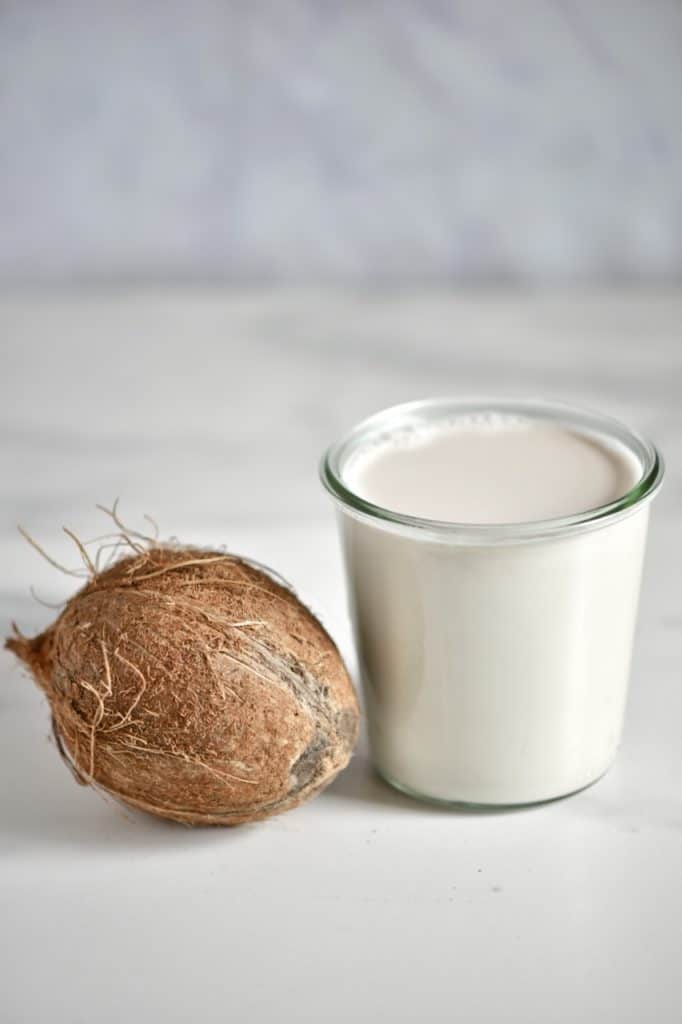
Of all the coconut products that you can make from a single coconut, coconut cream is the one that I always thought would be the hardest. Because of this, I put it off and put it off. Then I realised just how simple the process is, kicked myself and haven’t looked back since.
Coconut cream is such a simple coconut DIY that I’ve even included two methods. The first is more of a traditional method and is already super simple. However, the second method is even simpler – so simple in fact I’d call it a coconut cream ‘cheat’ (and all you need is a juicer).
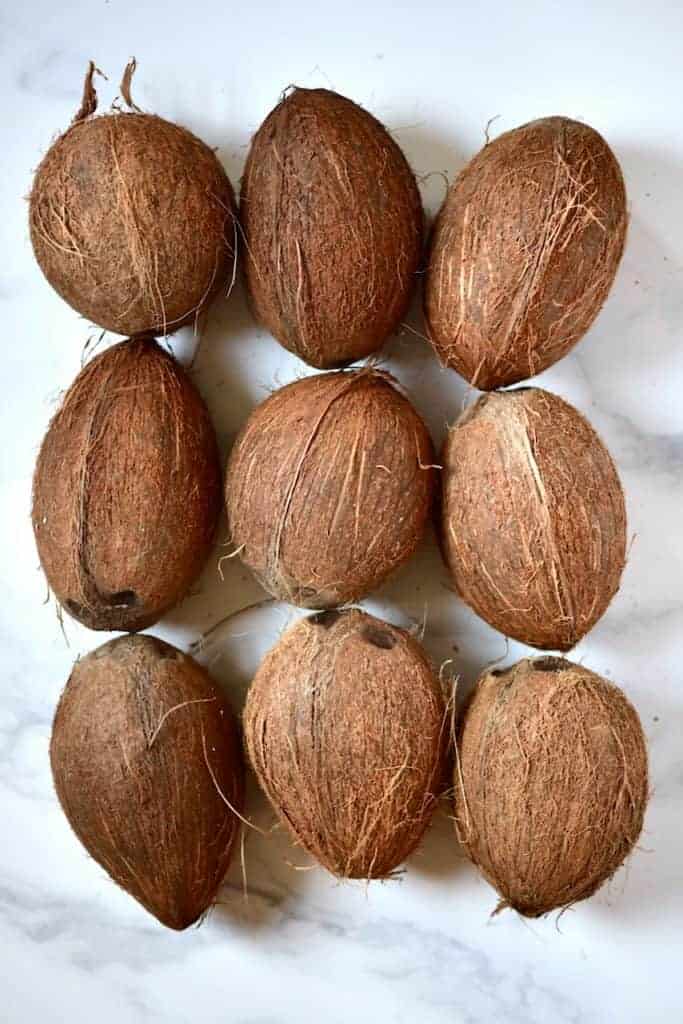
This recipe is gluten-free and great for those who are lactose intolerant or dairy-free as it can be used as a dairy replacement in so many recipes. Making it homemade also tastes so much better than canned (if I do say so myself) versions from grocery stores.
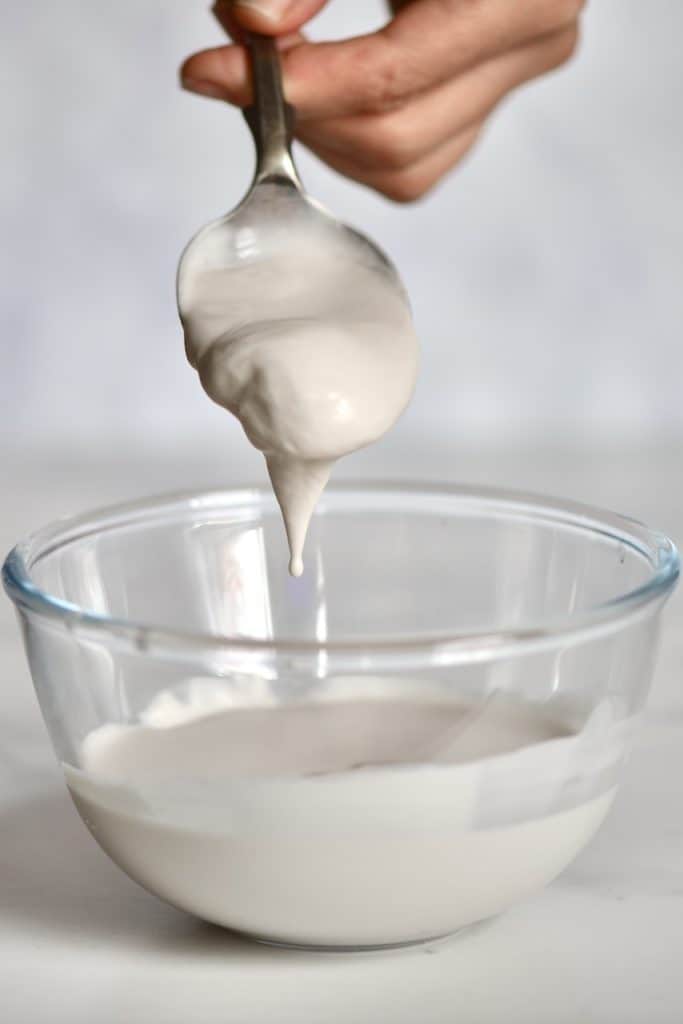
Plus, regardless of which method you decide to use – when making this cream, you’ll get the delicious by-product of desiccated coconut that you can then dry out and use for a variety of recipes.
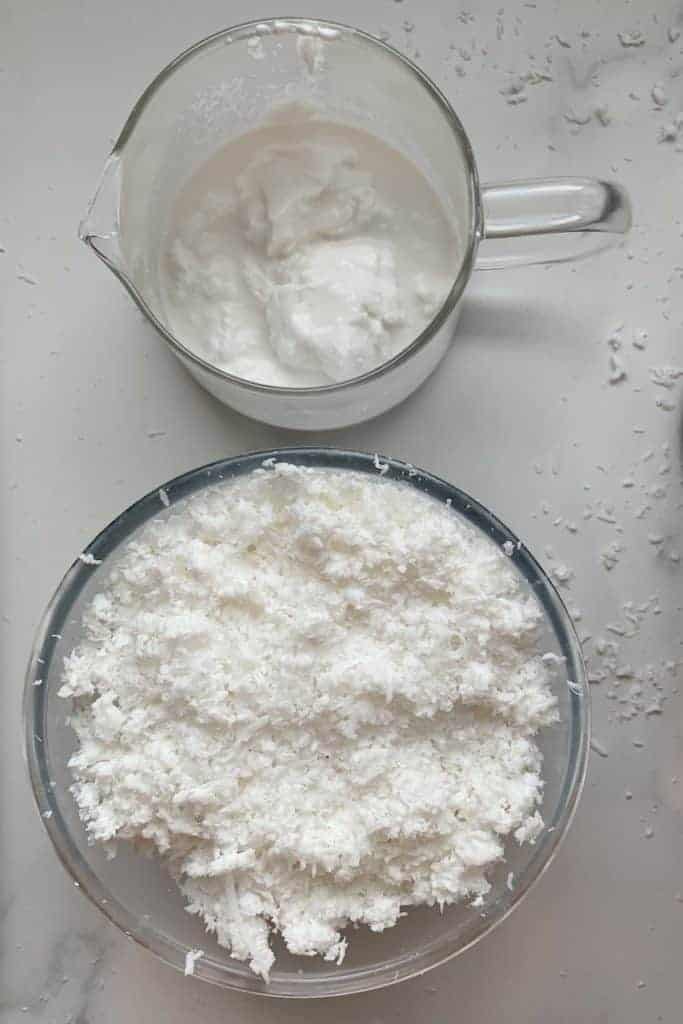
Want to save this recipe?
What is coconut cream?
I suppose the first question to answer would be, what exactly is coconut cream? I know there can be a lot of confusion surrounding this and what supermarkets label products. Particularly with confusion between coconut milk and coconut cream (and sometimes even cream of coconut).
Coconut milk and coconut cream are of course both made using the same ingredients (coconut meat and water) – but with slightly different processes. Coconut cream basically has a higher fat content and thicker, creamier texture like heavy cream – similar to dairy milk vs cream change in texture.
Plus, coconut milk is usually made using less coconut, combined with water. The cream, however, uses more coconut and requires the mix to separate (as you’ll see in the DIY below).
Note* Unless you’re using a juicer, as you’ll see in my second method!
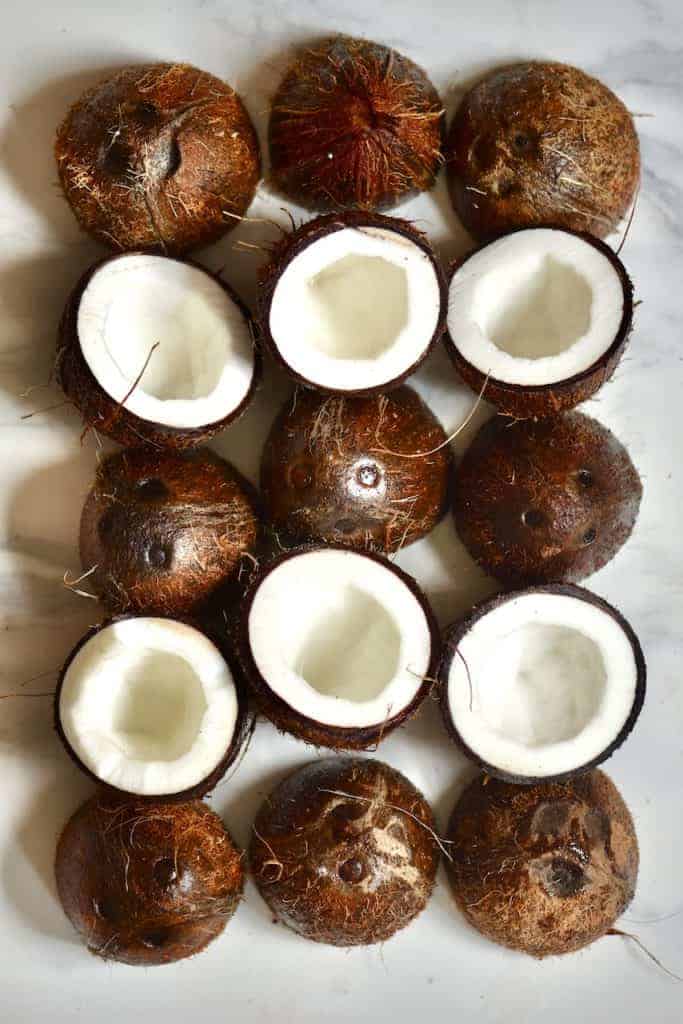
How to use coconut cream
So once you have your fresh coconut cream, it’s time to use it – of course. So, here are a few options for you:
- Probably one of the more traditional uses is within curries. Coconut cream adds a creamy element to a curry (like this Creamy Vegan Thai Green Curry), without watering it down as coconut milk does.
- The same can be said for soups. For example, adding some into this Creamy Butternut Squash Soup or Green Pea Soup.
- One of my favorite ways to use this is to make it into coconut whipped cream. You can then use this as a dairy-free ‘frosting’/cream for cakes.
- Likewise, it’s great to serve in place of dairy cream when served alongside pie or tart, warm puddings and more.
- Coconut cream is delicious when added to a variety of drinks – smoothies, milkshakes and even your favourite cocktail (piña colada anyone?)
- This isn’t something I’ve tried yet – but coconut cream would be an amazing part of a dairy-free ice-cream recipe.
- A whole variety of desserts could benefit from this dairy-free cream from mousses to pies, to tarts – like this Vegan Pumpkin Pie Recipe.
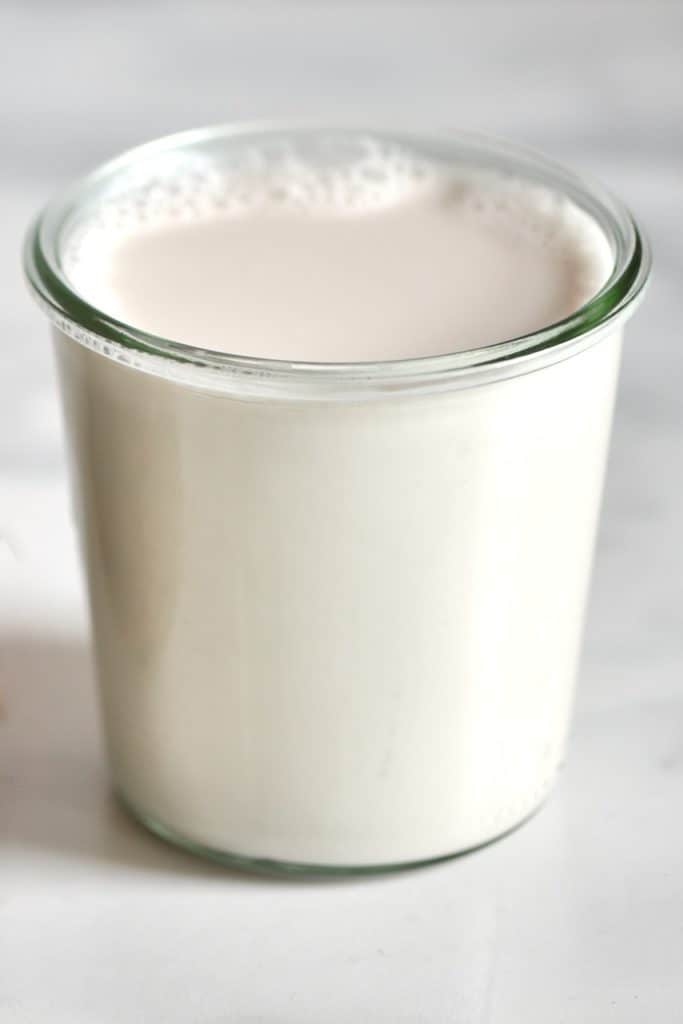
How to make coconut cream
Here I’m sharing the two methods to make coconut cream using matured coconut.
When making coconut cream, it’s worth noting that it has a short shelf life (just a few days) so is worth making in smaller batches. It’s hard to give you an exact amount of cream you’ll get out of each coconut, as this really depends on the size of the fruit and amount of meat inside.
When beginning to make coconut cream, start by experimenting with a couple of similar sized coconuts and you’ll quickly start to realise how many you need to make your perfect portion.
I used 9 coconuts to make a big jar of coconut cream which I quickly used to make whipped cream and decorate a cake.
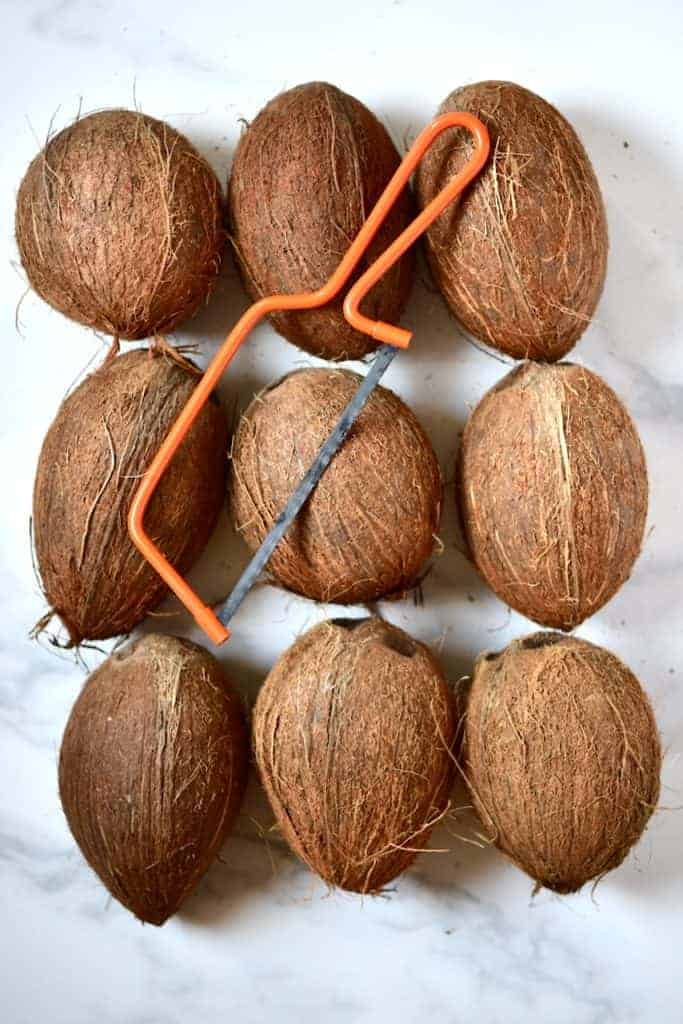
Method 1: Using a blender
Other tools needed: nut milk bag
Begin by extracting the coconut water from the coconuts. You can do this by using a screwdriver, nail or similarly sharp tool and create holes in the coconut eyes, to drain the water (which you can drink straight or add to smoothies).
Next, break the coconut shells and extract the coconut flesh. You can do this with a hammer, by banging it against a sharp/hard edge, with a small hand saw or any other favourite method of yours.
Note* you can then use the coconut shell to make DIY coconut bowls. However, if you want to do this – it’s best to use the saw method and cut them open through the middle. You might also want to skip the step of making the holes, but in this case, you might lose the coconut water unless you open it over a bowl and then strain the liquid.
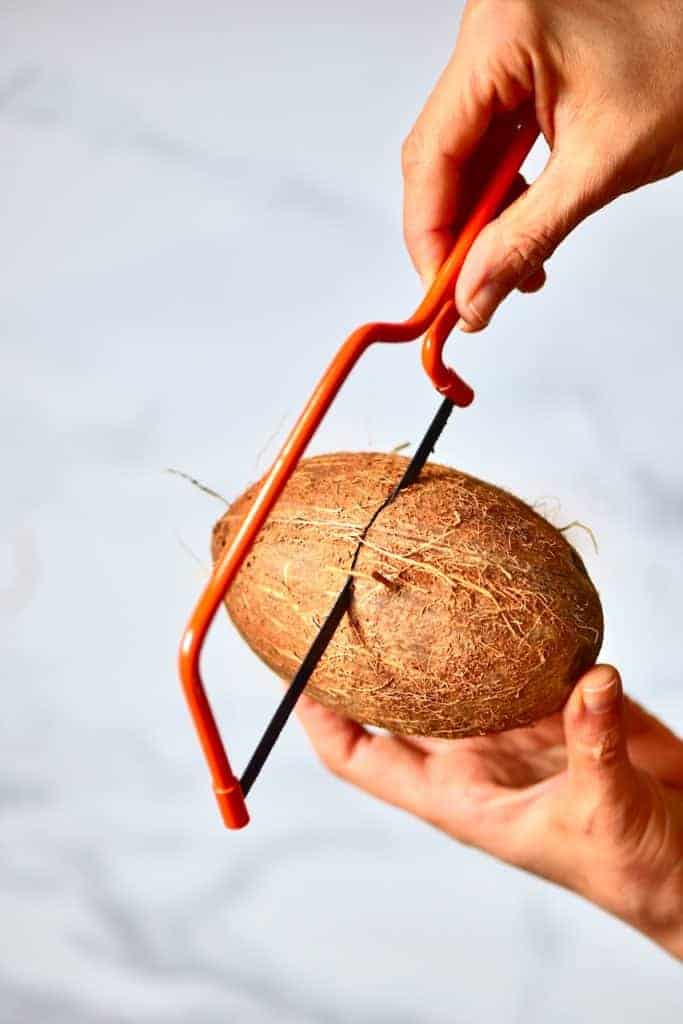
Pro tip: If you want to keep the coconut shells completely intact, after sawing them in half, put the coconut halves in the oven for 20 minutes at 170ºC. This will allow the coconut flesh to come out very easily.

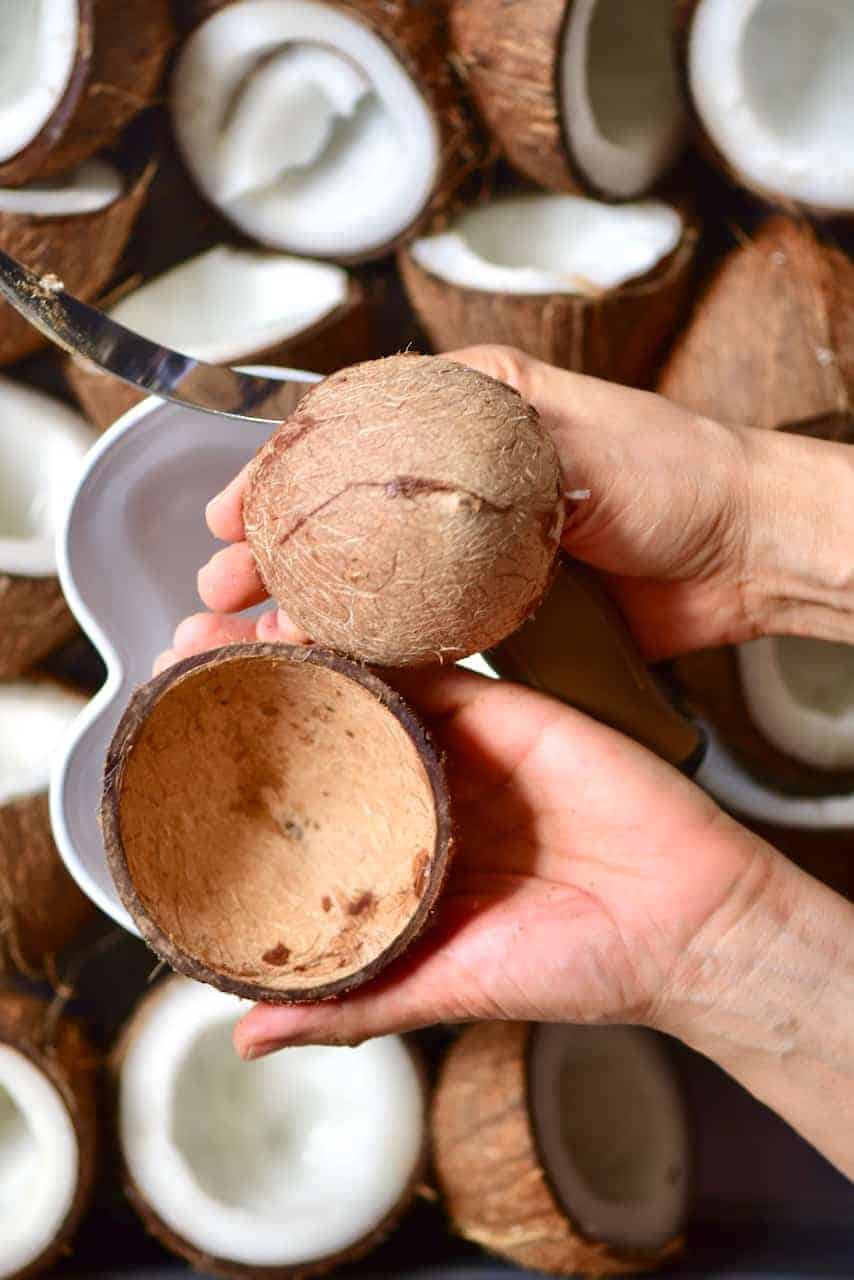


Next, add the coconut flesh to a high-speed blender/food processor and blitz to shred it. Add 4 cups of water and blend again to obtain coconut milk.
Note* for a creamier version, that uses dairy, you could swap out the water for semi-skimmed milk instead.
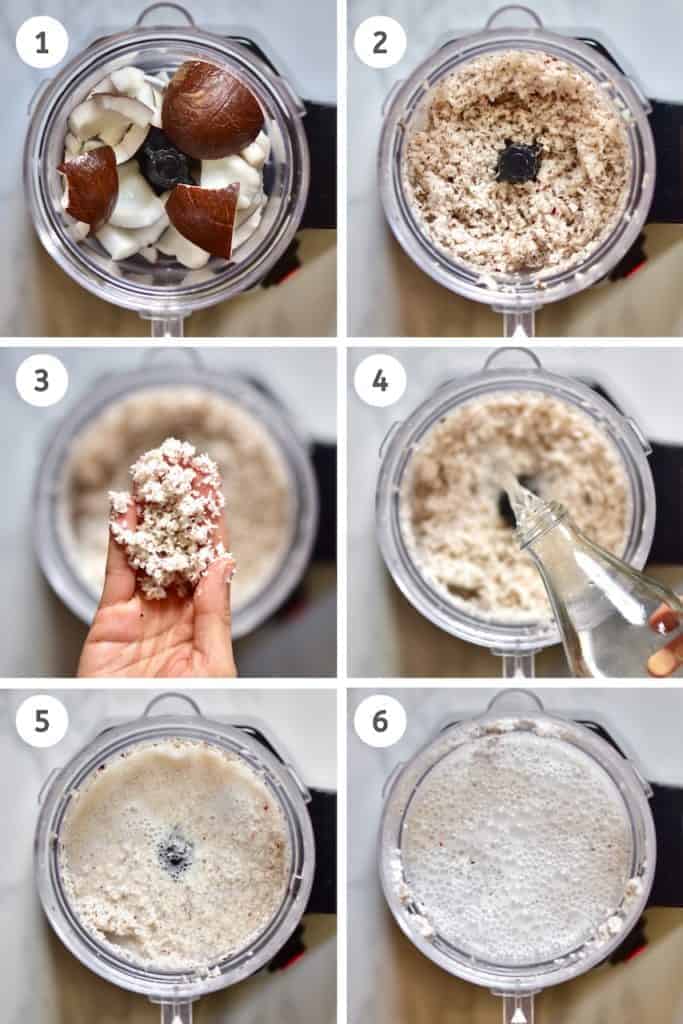
Note: depending on how many coconuts you are blending, you might have to do this multiple times. Not all the coconut flesh will fit in the blender if you’re making a massive batch. Also, it will be harder for the machine to blend very big amounts at once.
Next, pass the blended coconut milk through a nut milk bag and squeeze out all the liquid.
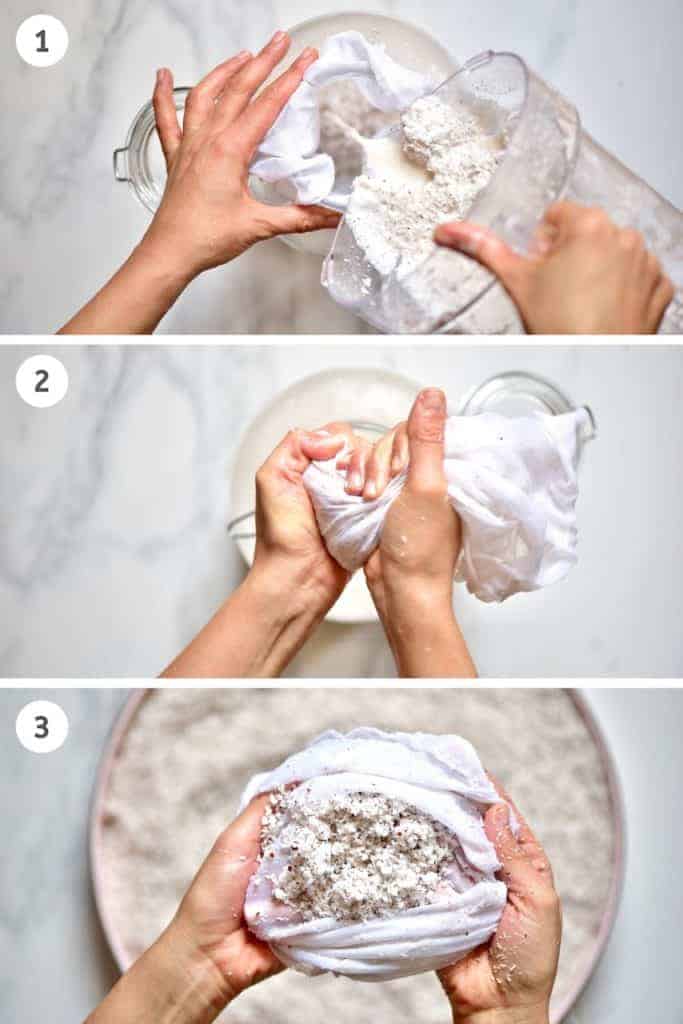
You can keep the remaining shredded coconut and dry it either in low temperature in the oven or out in sunny well-aired corner/window sill.
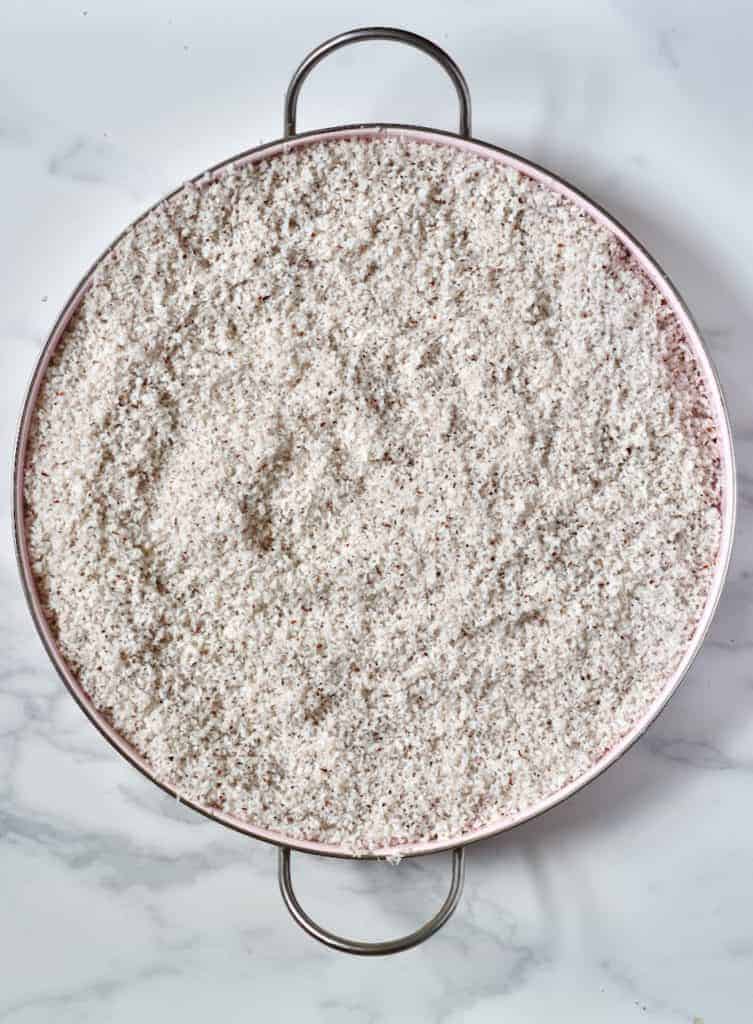
Next, pour the coconut milk into a big jar and set aside so that the creamy part separates from the watery liquid part. Using a dispenser tap jar works great as you can then easily remove the liquid part.
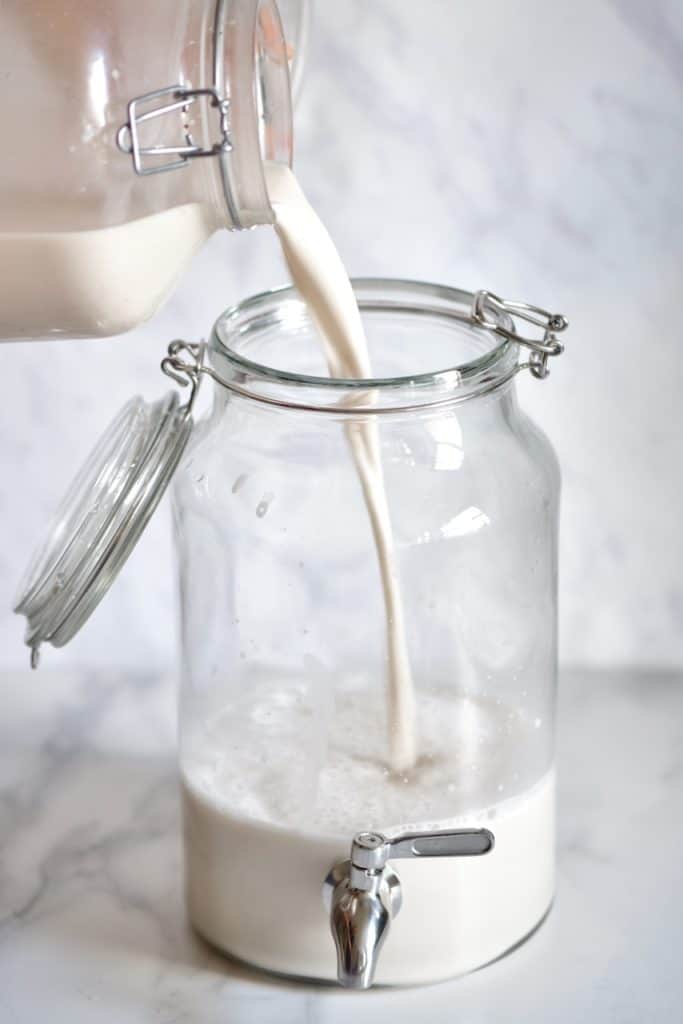
If using a regular container, you can scoop out the creamier part after the separation.
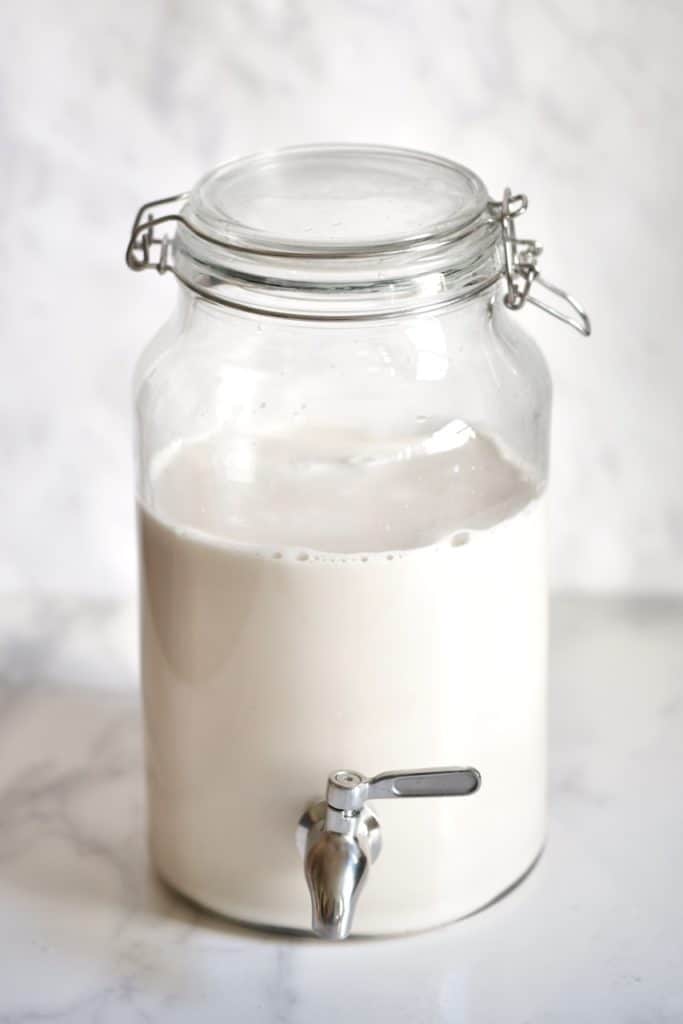
After some time, the cream will separate and rise to the top.
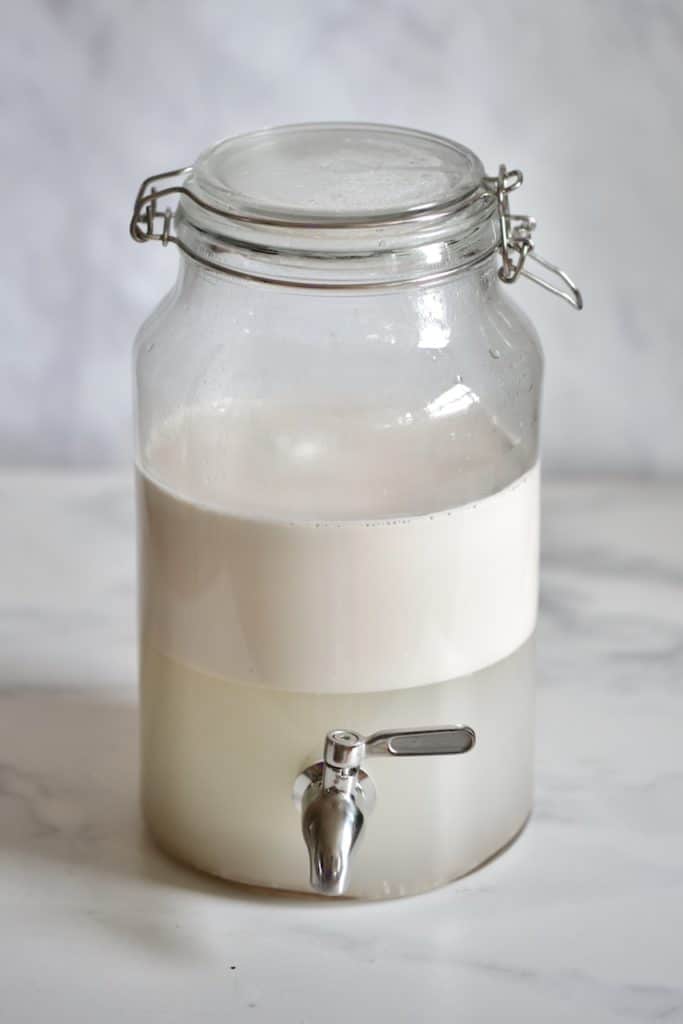
Remove the watery liquid through the tap. (Or carefully scoop out the cream from the top)
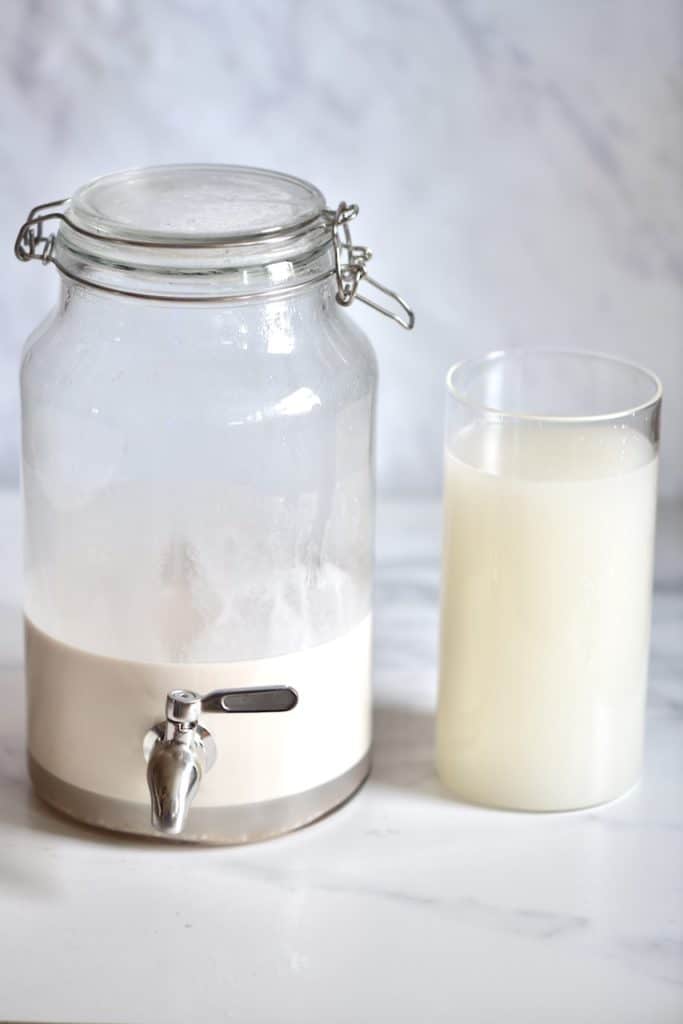
What’s left is the coconut cream.
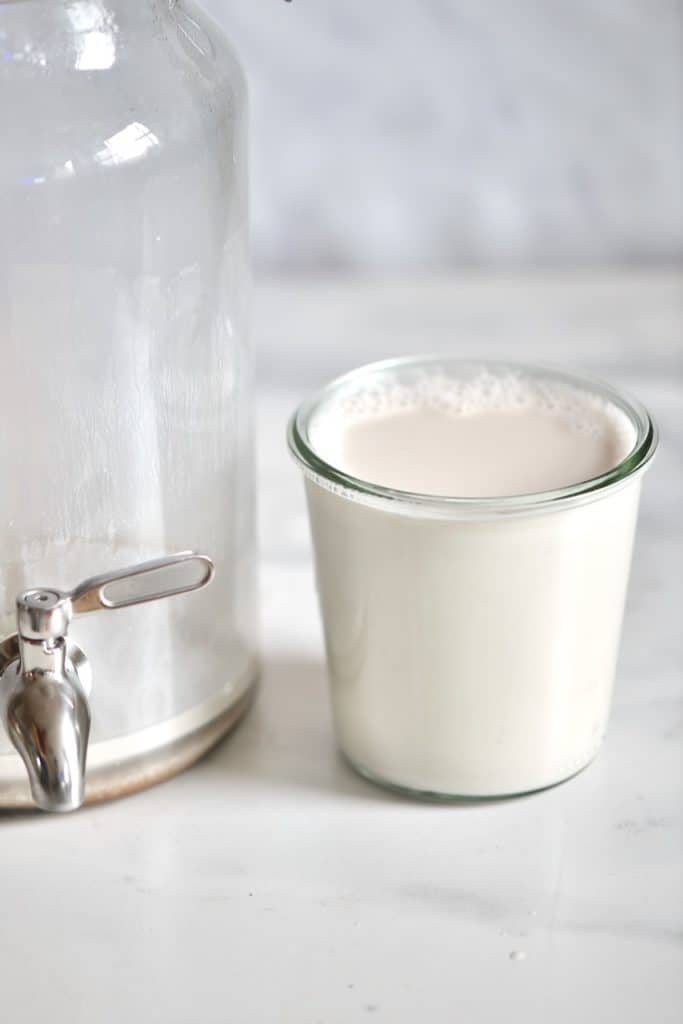
To make it even thicker, you can refrigerate and chill overnight. There will be even more water that separates in the jar.


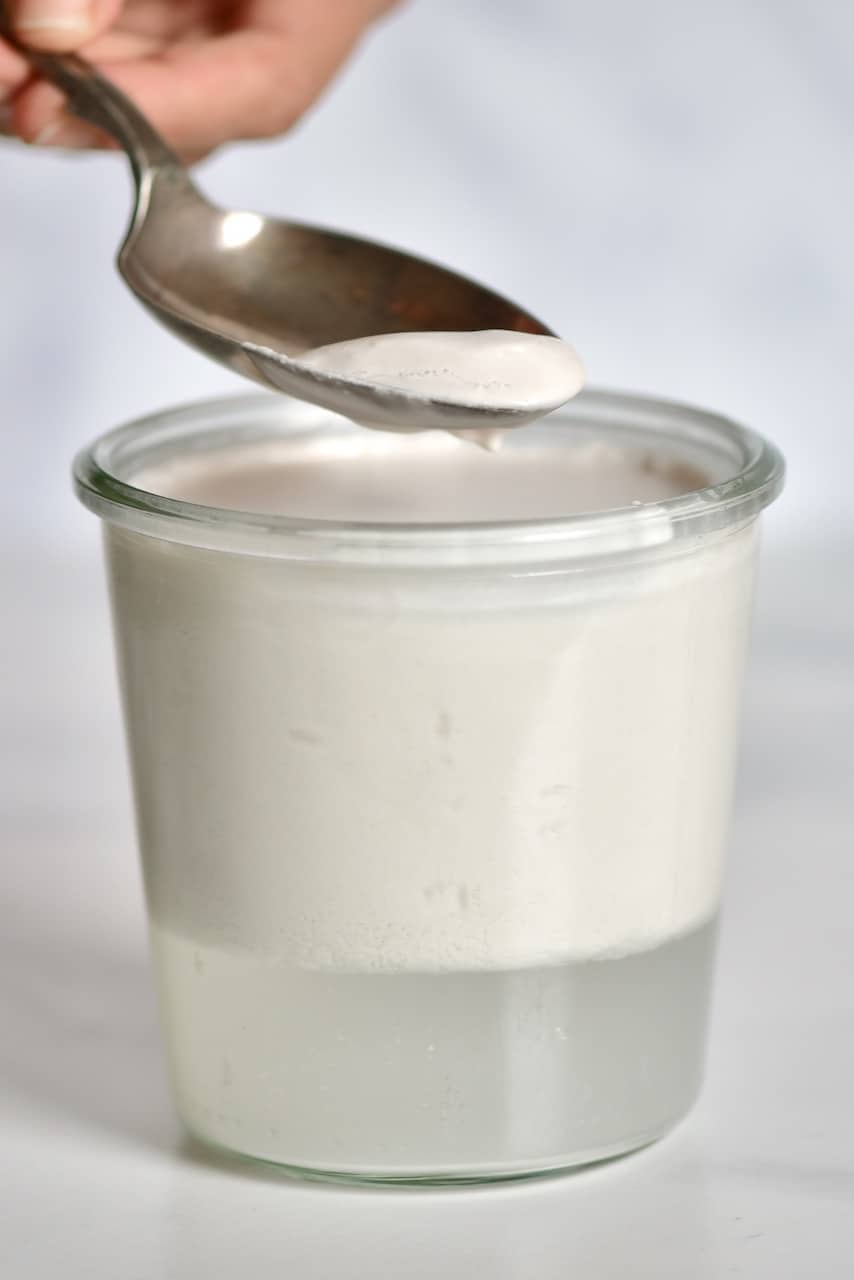
You can then scoop out the cream.
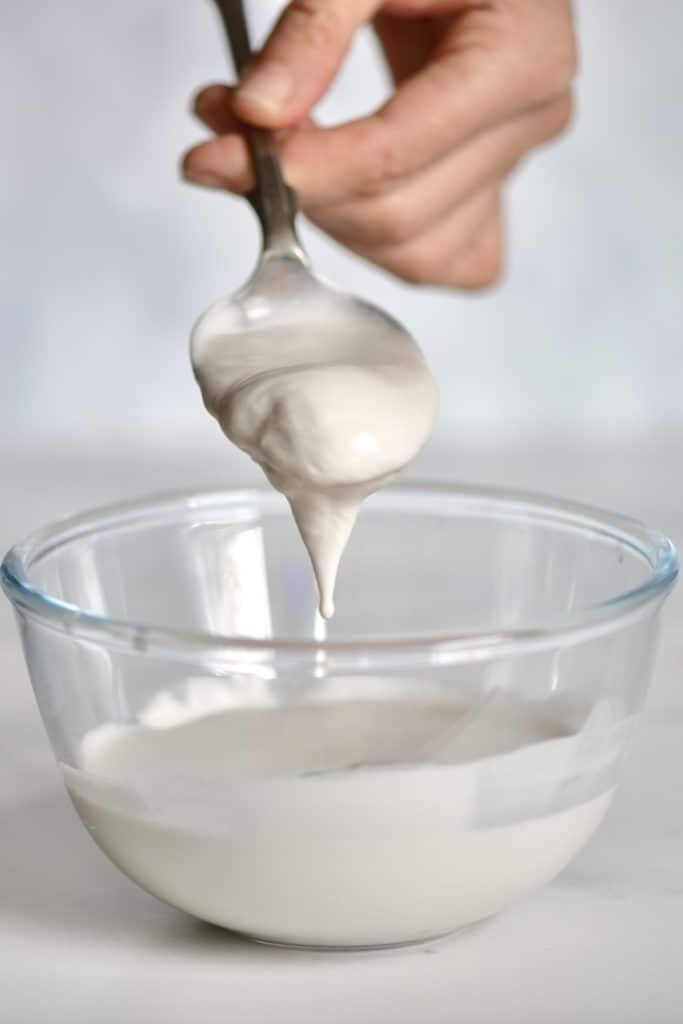
Method 2: Using a juicer
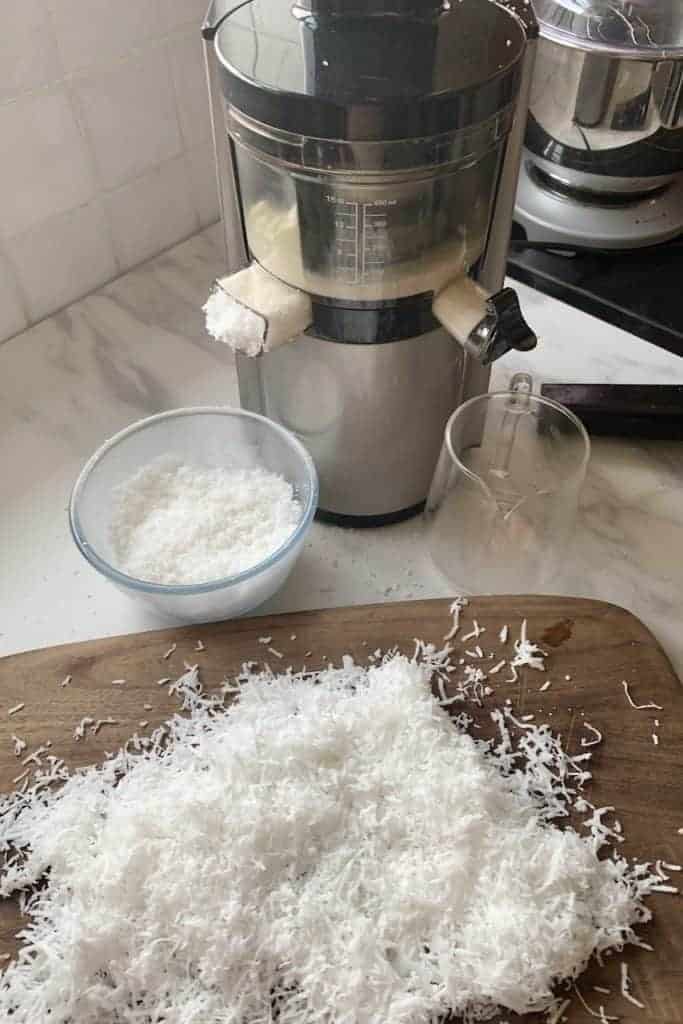
Once again, begin by draining your coconut water.
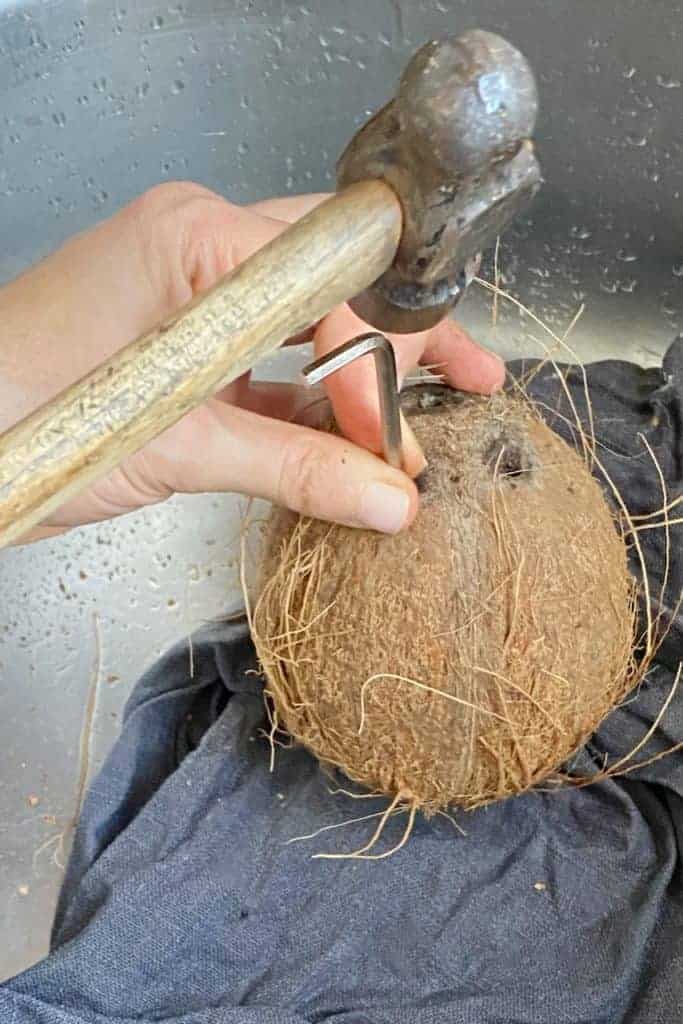
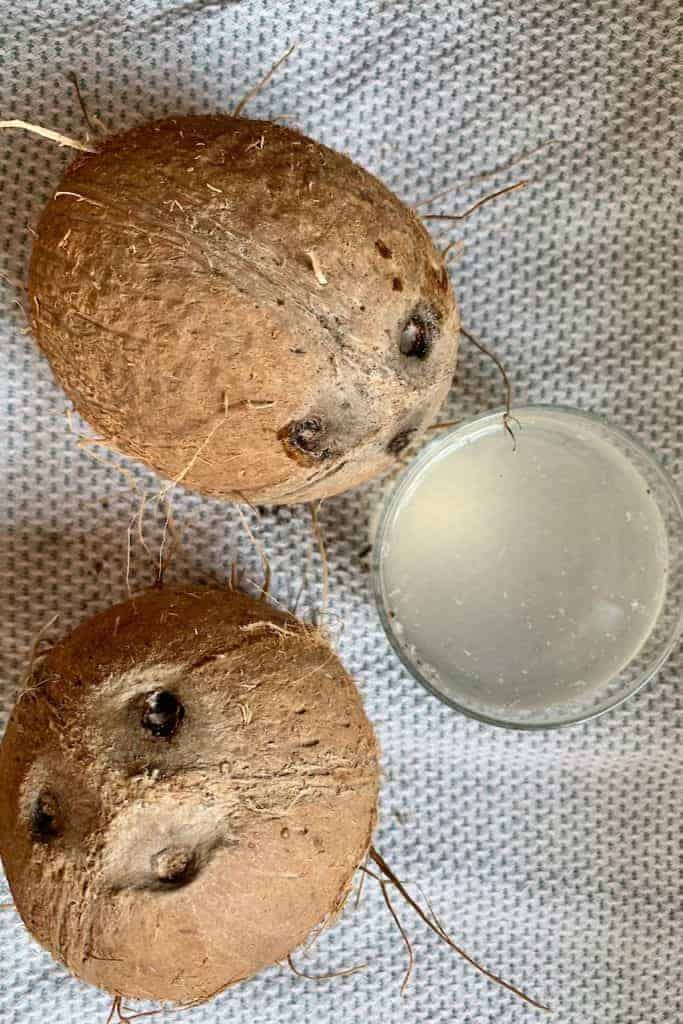
Break open the coconuts with a hammer or a hacksaw if you want to keep the shells.
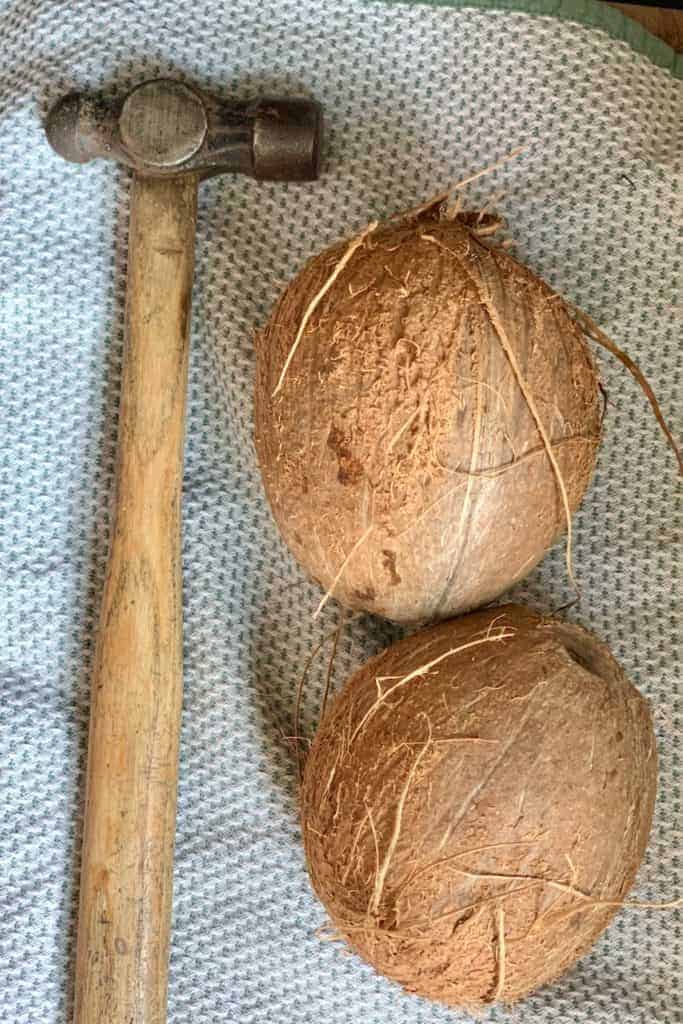
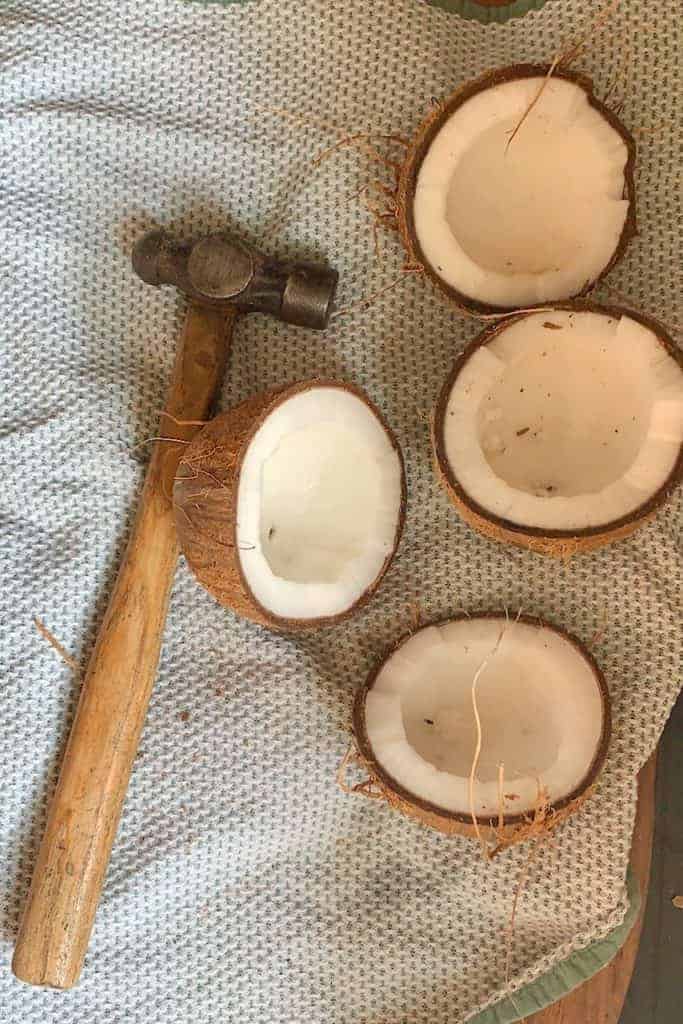
Remove the coconut flesh from the shells and peel the brown skin off.
Note* this brown part can be eaten as a snack, added to smoothies etc.
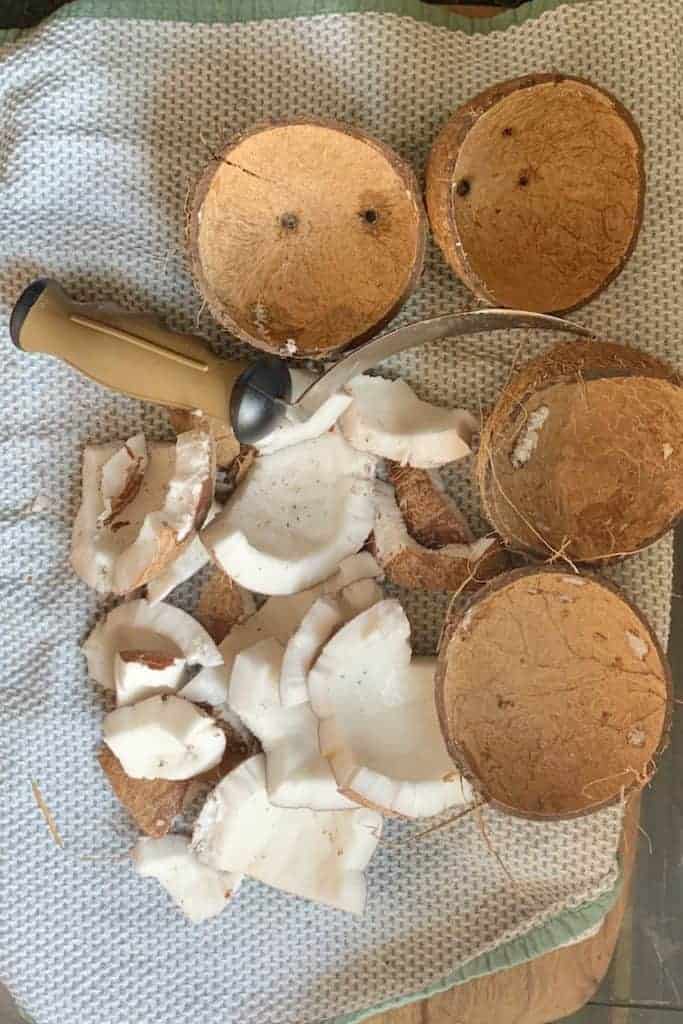
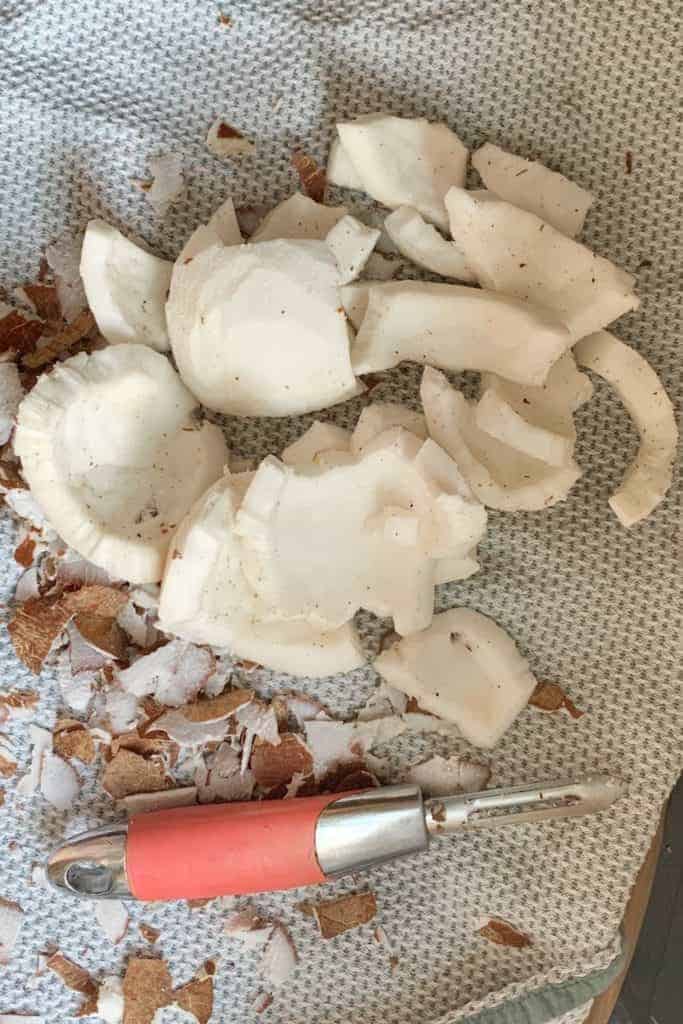
Tip: you can also leave the skin on but it would affect the colour of the cream and it will not be pure white; but the taste won’t change.
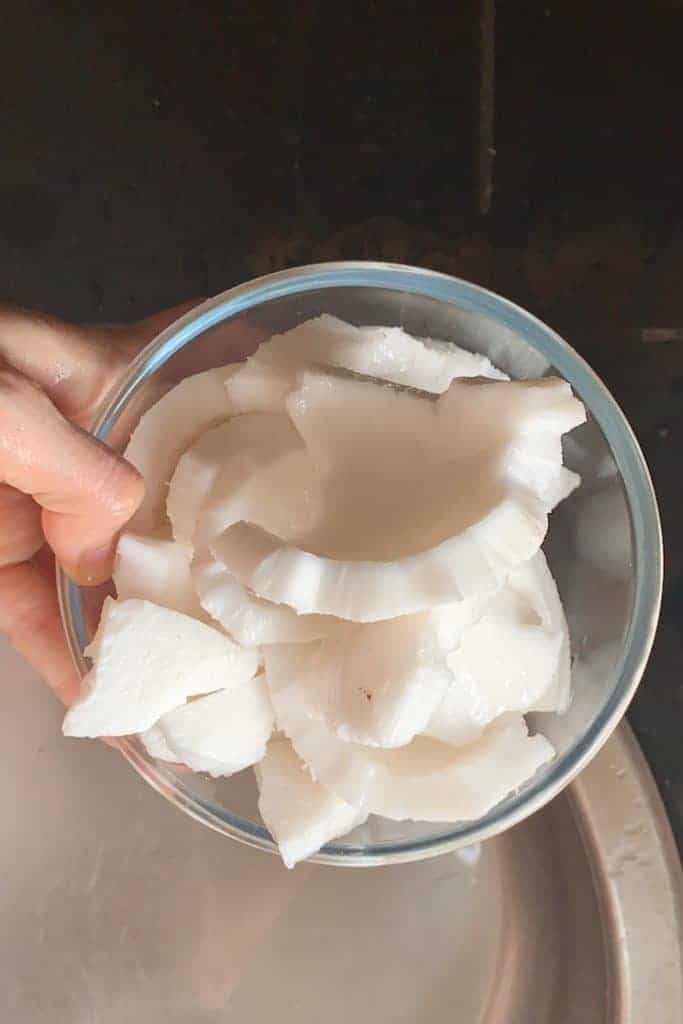
Pass pieces of the coconut flesh through your juicer (as you can see I sometimes use with the skin and sometimes without – depending on what I’m using the cream for).
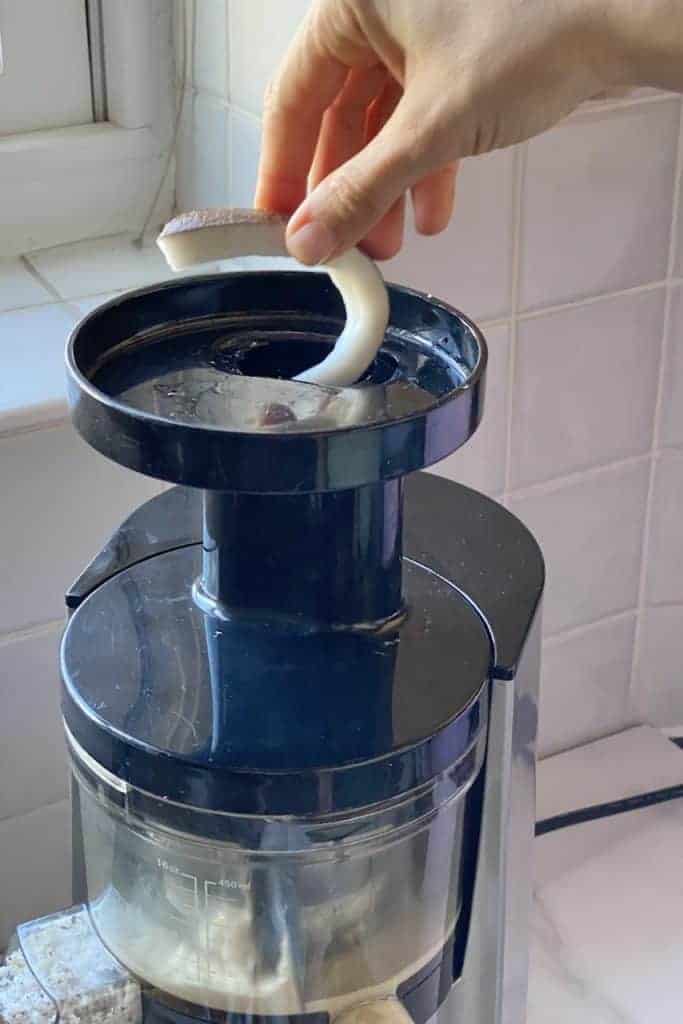
Voila! You get shredded coconut come out one shute and coconut cream from the dispenser- like magic.
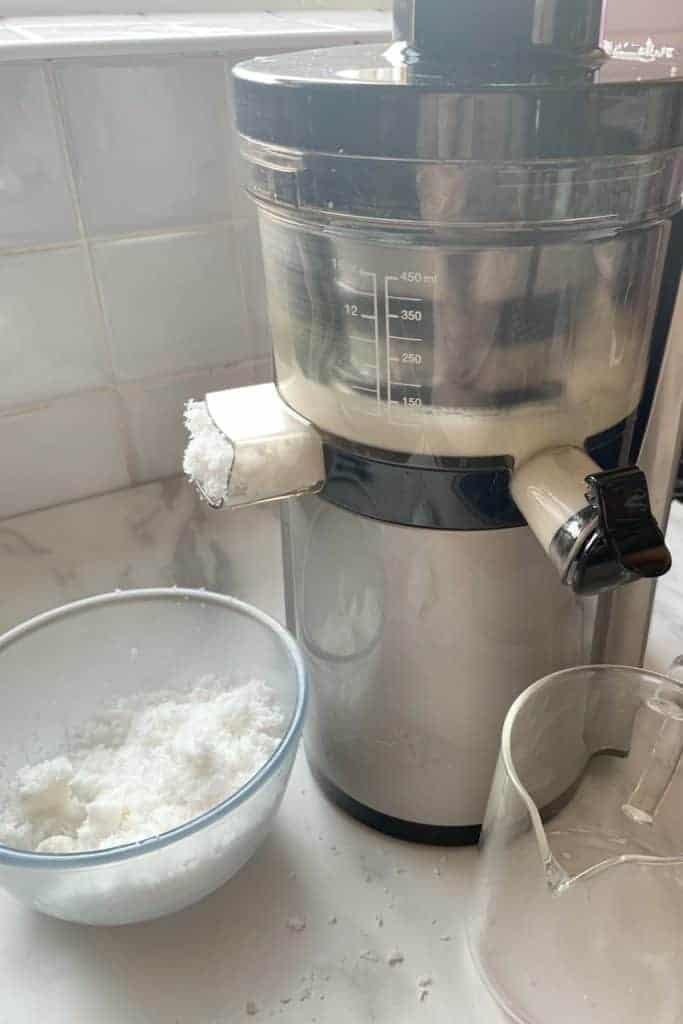
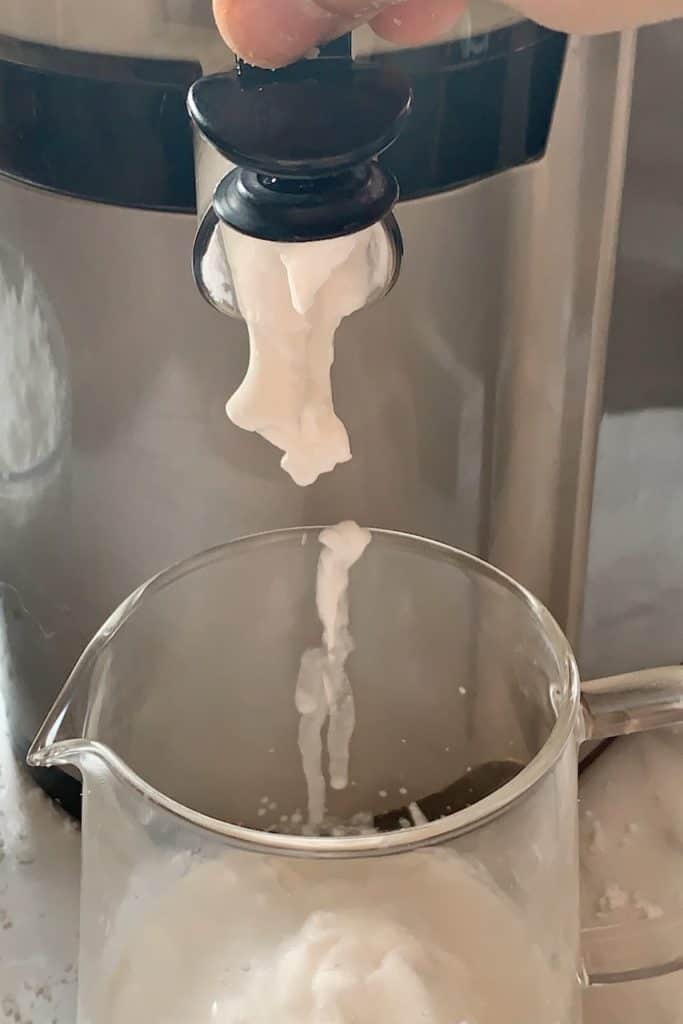
The shredded coconut coming out of the pulp dispenser (into the pulp container) is actually lower in fat too.
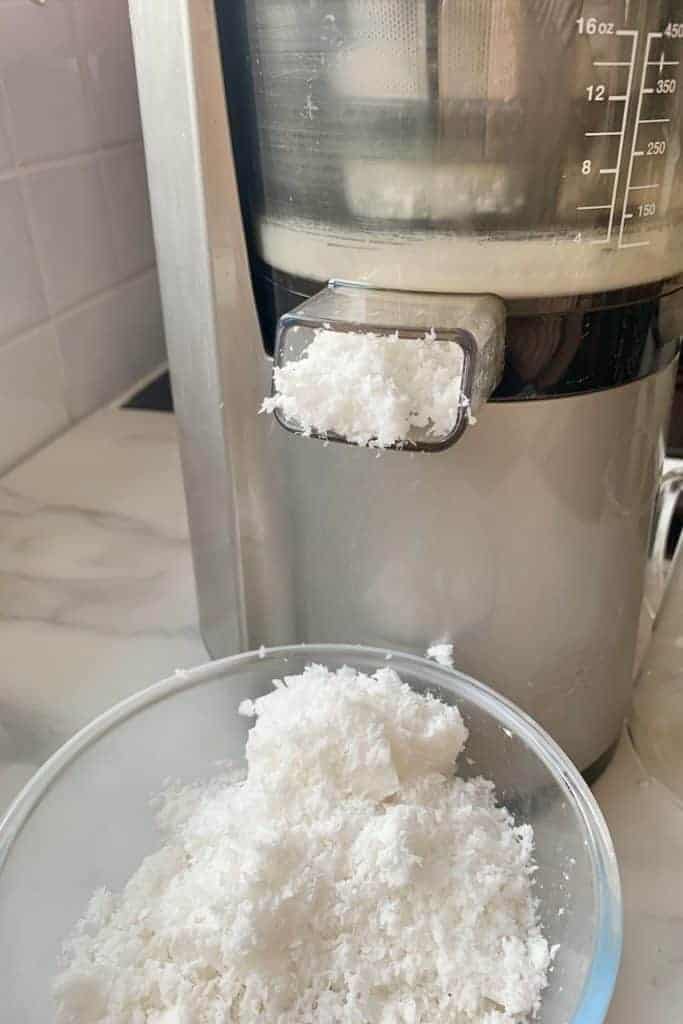
Your coconut cream is ready to use immediately or can be stored in the refrigerator in an airtight container for 3-4 days.
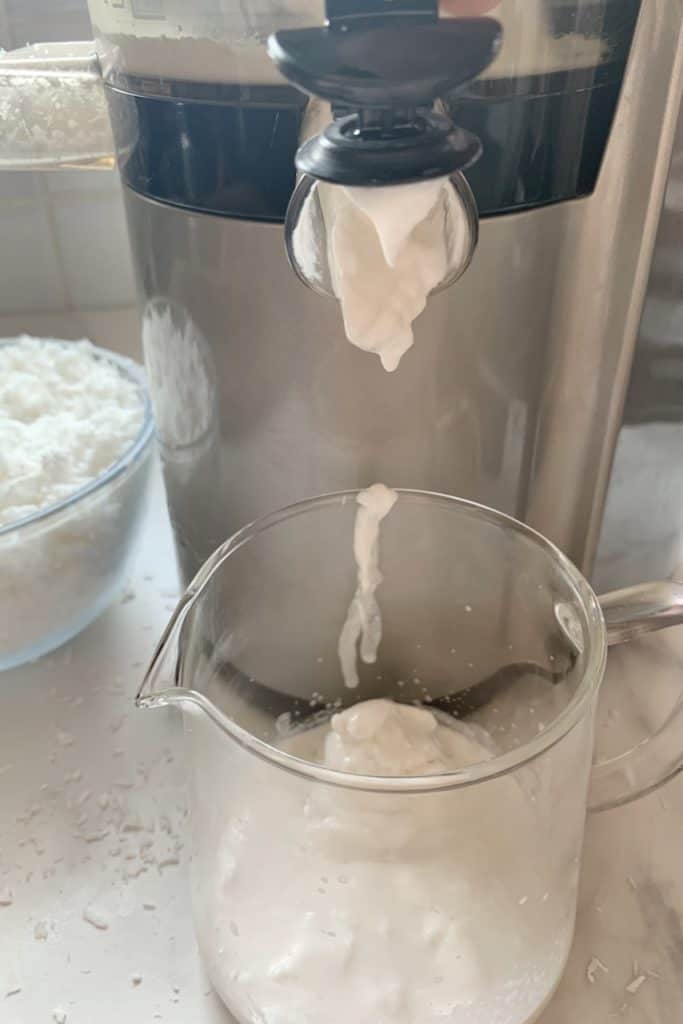
Other coconut DIYs you may like
If you’re not familiar with my coconut DIY obsession then you may not have seen that I’ve been working my way through pretty much everything you could possibly make with coconut. This includes Homemade Dairy-free Coconut Yogurt, How to make Coconut Butter, and even coconut sweetened condensed milk ( yes you read that right!).
If you give this DIY a try, I’d love to know your thoughts in the comments. Also, feel free to tag me in your recreations and how you use your homemade coconut cream @AlphaFoodie.
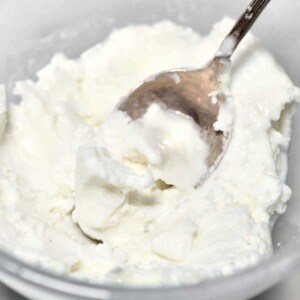
Easy Homemade Coconut Cream 2 ways
Equipment
- Hammer or a small hand saw
- Vegetable peeler (potato peeler) or a sharp knife (optional)
Ingredients
- Mature coconuts the amount is up to you. I used 9 to make a large jar of coconut cream
Instructions
The first step for either method: Opening the coconuts
- To keep the coconut shells 100% intact (to make coconut bowls), use a small handheld saw and cut them open through the middle. Do this over a bowl, to collect the coconut water. Otherwise, Begin by extracting the coconut water from the coconuts. You can do this by using a screwdriver, nail, or similarly sharp tool and create holes in the coconut eyes, to drain the water (which you can drink straight or add to smoothies).
- You can then put the coconut shells with the flesh in the oven for 20 minutes at 170ºC/325ºF. This is optional but it makes it easier for the flesh to come out of the shells. Alternatively use a knife, spoon, or coconut tool.
- You can peel the brown skin off the coconut flesh to get a pure white coconut cream when using a juicer (not required for the blender at all). This is an optional step. *
Method 1: Using a blender
- Add the coconut flesh to a high speed blender/food processor and blitz to shred it. Add 4 cups of water and blend again to obtain coconut milk. ** / ***
- Pass the blended coconut milk through a nut milk bag and squeeze out all the liquid. ****
- Pour the coconut milk into a big jar and set aside so that the creamy part separates from the watery liquid part and rises to the top. Using a dispenser tap jar works great as you can then easily remove the liquid part.
- Scoop out the coconut cream. Or, if using a dispenser tap jar, pour out the watery part and place in a smaller jar/container.
- Optional step: to make thicker cream, refrigerate overnight. It will separate further, to make even creamier cream on top. Scoop out the cream and it’s ready to use.
Method 2: Using a juicer
- Pass pieces of coconut fresh through a juicer. For a pure white cream, peel off the brown skin in advance.
- The coconut cream comes out in the juice container, low-fat shredded coconut comes out in the pulp container.
- Your coconut cream is ready to use immediately or can be stored in the refrigerator in an airtight container for 3-4 days.










Thank you for posting this recipe ,now I don’t have to buy canned coconut cream as they add preservatives which is not healthy.
Thank you so much for your comment. Glad you are enjoying this coconut cream recipe.
Hi Samira! Using the juicer method, would the cream be suitable for cocktails that call for cream of coconut, like Painkillers?
Hi Alex,
Yes, it should work really well in that cocktail.
hi love the blog was wondering can i make coconut milk from the shredded coconut from the juicer method
Hi Fateema,
While I’ve made coconut milk using shredded coconut and a blender (check this recipe –> https://www.alphafoodie.com/diy-homemade-coconut-milk/), I am not sure it will work with the juicer. When using the blender method, you add water to the shredded coconut.
I hope this helps.
Probably a dumb question. I only used one coconut. I probably should have scaled down the water right?
Hi Kristin,
Yes, it would have been better to use less water. You can still obtain coconut cream – maybe it would be better to go through the separation process two times so it comes out really creamy. I hope this helps.
I’m a first timer so didn’t get it right. I used four cups of water to mix with one coconut. No I guess I now have coconut milk? But tastes a bit watered down. I wonder if I will have any cream on top in the morning.
So, for making the cream, how much water do I mix with each coconut. And then when I remove the cream the left over water is really not good for anything, right?
Hi Rick,
In the recipe, I used 9 coconuts and 4 cups of water. You will have to use less water if you only use one coconut. Did you have any cream on top the next morning?
For one coconut, you can use about a ½ cup of water and for a really creamy version, you can go through the separation process twice. I hope this helps.
The leftover water is safe to use, I usually add mine to smoothies.
This is so great, thank you! Random question: where did you find your dispenser jar?
Thanks!
Thank you for your comment, Alexandre. I found the dispenser jar online.
Which brand cold pressed juicer used?
Hi Jenish,
The juicer is from Omega. There is a link for the exact model on the Shop page of the blog. Hope this helps.
Beautiful website and amazing photo, love it !!
Hi Andrea, thank you so much, very kind of you 🙂
that is grate thanks!!
What tape an model of juicer do you have ?
hi Andrea, thank you :). The juicer is from omega and I have a link for the exact model in my shop page. hope this helps.
Great idea, I live in the Philippines and we have an abundance of coconuts, made the cream and the milk and made homemade ice cream ! Everyone loved it , only thing is when it’s frozen, it’s very hard, no problem for us . And the wife used the discated coconut for macaroons
Thank you for your comment, Don.
How long will the frosting last in the refrigerator after I have frosted the cake?
Hi, Oreoluwa.
The coconut cream would last about 3-4 days in an airtight container in the fridge. If you use it to frost a cake, it would be best to consume the cake within 2 days. I hope this helps.
I tried making this following the first method, but it’s too watery. 🙁 The “cream” is not thick at all. What can I do to make it thicker?
If not thick, all you have is place it in the fridge and the water and the cream (thicker version) would separate! then all you have to do is scoop the cream out. I hope this helps!
Hi! I tried doing it in a juicer ( kuvings) and I didn’t get coconut cream but coconut milk 🙁
Any advice or any comment about omega I’m this happened?
Hi Adriana, Sorry to hear about that, it depends on how hydrated are the coconuts you are using. But all you have to do is let this rich milk to sit in the fridge for couple of hours and then the cream will float! Hope this helps!
hi could u share few recipes with coconut milk n cream
Hi Manu,
I have multiple recipes you can look at on my blog. 🙂 You can add it to soups, use it to flavor rice, make drinks with it, etc.
Hey Samira! So with the blender method for the coconut cream, when the water is separated, can we use that water Or drink it or is it not okay to do that??
By the way, i love your blog, have been following you in instagram for years!
Hi Stuti, thank you so much and I am so sorry for the late reply. The water is totally safe to use. I normally add it to smoothies :). Hope you’re having a wonderful week :).
I always use the coconut water to make the coconut milk or creme. I then drink it or blend with cucumber and lime and honey& mint & strain. So good.
This combination sounds delicious. Thanks for sharing, Gina.